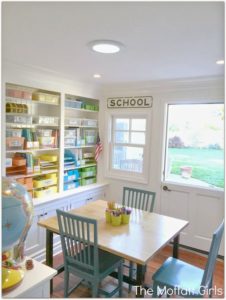How to Set Up a Room for Homeschooling
In the last decade, the number of adults who have chosen to educate their children at home has risen by nearly 68% (CNS News). In total, this number is at 1.7 million and only continues to grow.
Particularly in the younger years, a secure, safe, and comfortable learning environment can make a difference in a child’s academic performance.
Are there distractions? Does it feel like just playing around at home?
Because of this factor, many dedicate an entire room in their home to homeschool their kids. There are ways to design the layout and functionality of a classroom and personalize it to cater to your child; but we have looked to some long-time homeschooling parents who know what they’re talking about when it comes to designing a classroom and utilizing the space wisely.
Many parents and teachers may differ on curriculum which may affect the layout of your preferred room, as the content of certain lessons vary. Much of this also can be determined by the age of your children.
Organization
Cabinets, drawers, closet space – all storage should be designed to conceal items not in immediate use, as it could therefore detract from the learning environment. This allows you as a parent to call upon certain objects when the lesson calls for it. Unnecessary clutter can cause stress for the parent and aid a child in becoming sidetracked, especially if they become so easily.
Artwork
For a child to feel encouragement and at ease, many recommend decorating in some areas of the room with your own child’s artwork. There is a way that this can be done without a total overload (especially if you have a child that likes to draw a picture on every piece of paper that they’ve ever seen). For example, take a giant frame without glass or backing (you may be able to find a large enough one at a thrift shop, junkyard, or garage sale) and tie wires from each end and hang artwork from clothespins (see below).
Desk/Table Area
Many recommend that a desk or working area is situated away from walls; with pencils and other writing utensils at the center. For a pop of color, try placing a patterned or colored rug underneath (this will also aid to cleaner carpets in the long-run).
Arrangement of Furniture
Many ideal home-school spaces found via web are arranged similarly. One thing that nearly all of them have in common is the fact that different activities (crafting, hands-on learning, enrichment) are closer to the edges of the wall, and the main learning and work space is the focal point at the center (usually characterized by the table, as stated before).
Wall Decor
For most, a decent sized world map is a must. The more frequently your child is able to glance at maps, the more their geography will improve (for geography tests, maps can easily be covered).
Something that is truly trending right now (and not just for homeschoolers) is the added element of chalk paint on one or more walls. This can aid to explaining a lesson if you are teaching more than two kids at once; it can also aid to writing a visual schedule for the children to see. Whether you elect to set aside a wall or two for painting or not (say for example, maybe you are renting your home and you cannot), make sure there is at least a written schedule up on the wall. This will communicate so many things: telling time, time management, self-discipline, and more.
Judging how to decorate the remaining walls is similar to how you want to decorate the rest of the room: not too cluttered. Use your display wisely; and ask yourself the similar questions: will this aid, or distract?
Have a Small (or Large) Library
Having a special reading nook (especially one that looks cozy and inviting) with select books will encourage focused, leisurely, and distraction-free reading; aiding to those perhaps well-needed moments of silence throughout the hectic school day.







